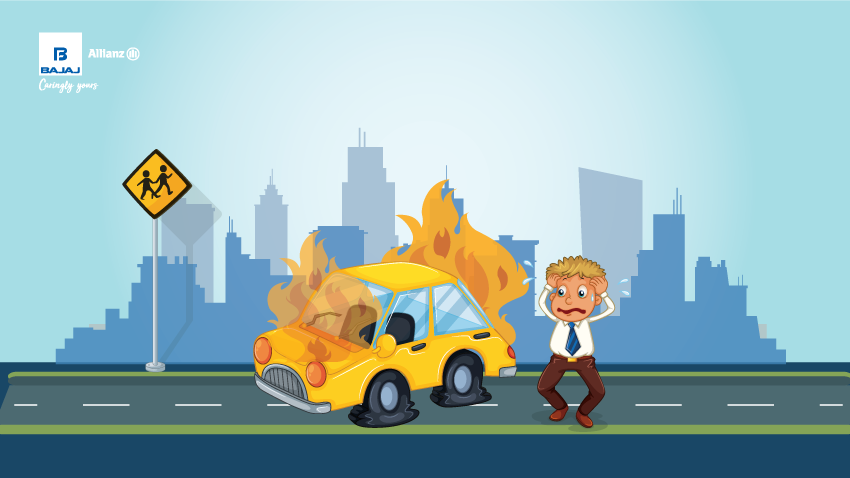An unexpected car fire is a situation that, while rare, can be incredibly frightening and dangerous. Knowing how to react swiftly and calmly can make a crucial difference in ensuring your safety and the safety of others on the road. Let’s explore the essential steps to take in case your car catches fire, turning a potentially disastrous scenario into a manageable one.
Tackling Car Fires
One can never be prepared for an instantaneous situation such as a car fire. As car fires generally happen in an instant, having a proper idea of dealing with it can help in averting a bigger risk. And while a fire can severely damage your car, you can manage the cost of repair or replacement with the help of your
car insurance. Claims are subject to terms and conditions set forth under motor insurance policy.*
Here's a Step-by-Step Guide to Help You Deal With a Car Fire
Pull Over Safely
If you notice smoke or flames emanating from your vehicle, find a safe place to pull over immediately. Avoid stopping on busy highways or narrow roads where escaping the vehicle could be difficult. Look for an open space away from traffic, such as a parking lot or the shoulder of the road, to minimize the risk to yourself and others.
Turn Off the Engine
As soon as you come to a stop, turn off the ignition. This helps cut off the fuel supply to the engine, reducing the risk of the fire spreading. Engaging the emergency brake is also crucial to prevent the car from rolling, especially if the fire has compromised the braking system.
Evacuate Safely
Once the engine is off, evacuate the vehicle promptly and calmly. Do not attempt to retrieve personal belongings, as your safety takes precedence. Exit the car and move to a safer distance away from the car. If you have passengers, ensure everyone gets out quickly and is at a safe distance from the vehicle.
Do Not Open the Hood
Opening the hood might seem like an instinctive reaction to addressing a fire, but it's a critical mistake. The rush of oxygen can intensify the flames, escalating the situation. Instead, focus on getting everyone out of the vehicle and to a safe distance. Leave firefighting to the professionals.
Call Emergency Services
Once you are at a safe distance, call emergency services immediately. Dial the local emergency number to report the incident. Provide clear and concise information about your location, the fact that your car is on fire, and the presence of any injuries.
Use a Fire Extinguisher (If Safe to Do So)
If you have a fire extinguisher in your vehicle and the fire is small, you may attempt to use it to suppress the flames. However, this should only be done if it is safe, and you feel confident in operating the extinguisher. Keep in mind that a fire can spread rapidly, so use the extinguisher only if the fire is in its initial stages and you can do so without putting yourself at risk.
Inform Authorities of Hazardous Materials
If you are carrying hazardous materials, such as propane tanks or chemicals, inform the emergency services of the same when you call. This information is crucial for responders to handle the situation safely and efficiently.
Do remember if the cause of fire was any hazardous material that was present in the car, you may face complications with your
motor insurance claim. Be open and transparent about everything at the time of filing your claim.
Claims are subject to terms and conditions set forth under motor insurance policy.*
Cooperate with Emergency Responders
Once emergency services arrive, follow their instructions, and cooperate fully. They are trained to handle these situations and will take the necessary steps to extinguish the fire and ensure the safety of everyone involved. Provide any additional information they may need about the contents of the vehicle or any other potential hazards.
Preventive Measures: Reducing the Risk of Car Fires
While no one anticipates a car fire, certain preventive measures can reduce the risk of such incidents:
Regular Maintenance
Ensure your vehicle undergoes regular maintenance, including checks on the electrical system, fuel system, and engine components.
Checking for Leaks
Keep an eye out for any leaks under your vehicle, especially fluids like engine oil or coolant. Address any leaks promptly.
Watching Warning Signs
Be vigilant for warning signs such as unusual odours, smoke, or dashboard warning lights. These could be indicators of potential issues that need attention.
Follow Manufacturer’s Instructions
Adhere to the manufacturer's weight recommendations. Overloading your vehicle can strain its systems, increasing the risk of mechanical failure or fires.
Conclusion
While car fires are rare, knowing how to react swiftly and safely can make all the difference. Staying calm, evacuating the vehicle promptly, and calling emergency services are key steps in ensuring your safety and the safety of others on the road. By understanding the proper procedures and taking preventive measures, you can navigate this challenging situation with confidence and composure. Securing your car’s safety and your own with an insurance policy also helps in such dangerous situations. Get the policy that meets your expectations, with the help of
car insurance calculator.
*Standard T&C Apply
Insurance is the subject matter of solicitation. For more details on benefits, exclusions, limitations, terms, and conditions, please read the sales brochure/policy wording carefully before concluding a sale.
 Service Chat: +91 75072 45858
Service Chat: +91 75072 45858


